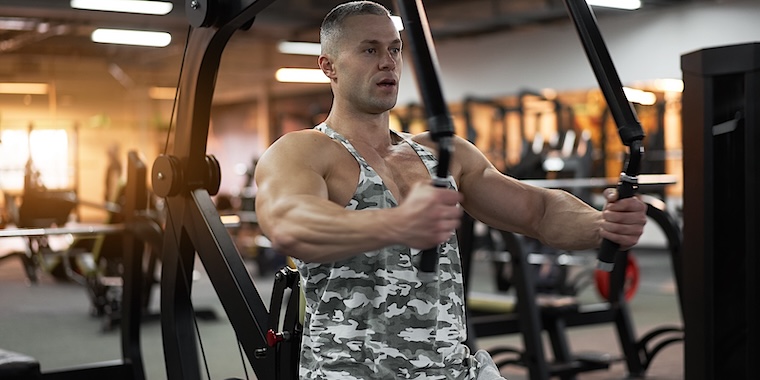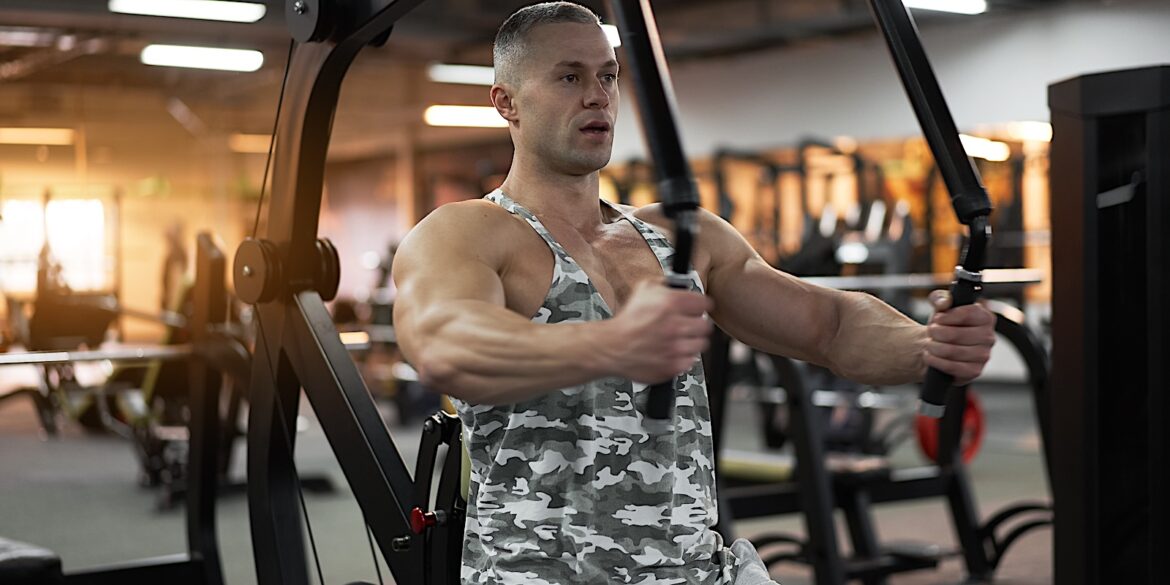Clean bulking may be the way forward.
Despite years of training, many lifters can become discouraged by their lack of muscle gains. In June 2025, veteran natural fitness influencer Sean Nalewanyj broke down seven culprits that prevent athletes from being able to show off their hard work in the gym and how to course-correct.
7 Reasons You’re Not Growing
How to Look Like You Lift
1. Being Too Lean
Nalewanyj challenged the trendy advice that one can stay shredded year-round and gain muscle. “Don’t think that you can maintain 10% body fat all year and just magically synthesize a significant amount of new muscle out of thin air,” Nalewanyj dispelled.
At a low body fat percentage, the body lacks surplus energy needed for growth. That doesn’t mean recklessly dirty bulking. Instead, aim for a modest caloric surplus — around 200-300 calories above maintenance, yielding one to two pounds of monthly weight gain.
Gradually increase in small increments as needed. Macronutrient ratios and meal consistency are important; creatine can boost progress. (1) Optimal bulking macros, according to literature:
- 45–60% of calories from carbs
- 30–35% of calories from protein
- 15–30% of calories from fat
2. Bulking Inconsistently
Addressing fears of abs fading from the mirror, Nalewanyj suggests not panicking over social media skewing body fat percentages; 15-20% of body fat is misjudged as overweight, but it’s a realistic range to see real progress. “You must spend time in a softer state to maximize long-term progress,” Nelwanyj affirmed.
Starting and stopping a bulk after a few weeks isn’t enough time for the body to adjust and grow.
3. Lack of Training Intensity
Studies show intensity is advantageous for muscle growth. (2) Moreover, size is typically a byproduct of increased strength. Using heavy, but not maximal loads, maximizes mechanical tension and may bias the larger fast-twitch muscle fibers.


Training close to failure, or leaving up to two reps in reserve (RIR), is generally considered the gold muscle-building standard. (3) Hypertrophy is dose-dependent, meaning strategically increasing workloads drive more gains. While overtraining is possible, it’s not easy to achieve. (4)(5)(6)(7) The trick is gradual progression. (8)(9)
4. Over-Focusing on Mirror Muscles
Many intermediate and advanced lifters prioritize their favorite muscle groups. Optimizing back, shoulder, triceps, and leg training contributes to what most consider desirable aesthetics. Neglecting those body parts could lead to imbalances that eventually require playing catch-up.
5. Shiny Object Syndrome
Jumping between influencer routines often leads to “no objective measure to track progress.” It’s hard to gauge adaptation without tracking training variables. Pick exercises that feel good and focus on progressing those lifts. (10)
6. Copying Elite Lifters’ Routines
Nalewanyj warned natural lifters against mimicking the intense regimes of enhanced lifters. “Steroids are not just the icing on the cake. They’re literally like 50% of the cake,” he joked.
Performance enhancers are a boon to recovery in a way that is not equally available for drug-free trainees. Instead, natural athletes should follow a more personalized program centered around recovery.
7. Unrealistic Expectations
“Relatively speaking, building muscle doesn’t take that long, but it doesn’t happen overnight,” Nalewanyj concluded. A proper physique transformation takes years of consistency, so be patient and trust the process.
More Bodybuilding Content
References
- Iraki J, Fitschen P, Espinar S, Helms E. Nutrition Recommendations for Bodybuilders in the Off-Season: A Narrative Review. Sports (Basel). 2019 Jun 26;7(7):154. doi: 10.3390/sports7070154. PMID: 31247944; PMCID: PMC6680710.
- Mangine GT, Hoffman JR, Gonzalez AM, Townsend JR, Wells AJ, Jajtner AR, Beyer KS, Boone CH, Miramonti AA, Wang R, LaMonica MB, Fukuda DH, Ratamess NA, Stout JR. The effect of training volume and intensity on improvements in muscular strength and size in resistance-trained men. Physiol Rep. 2015 Aug;3(8):e12472. doi: 10.14814/phy2.12472. PMID: 26272733; PMCID: PMC4562558.
- Robinson ZP, Pelland JC, Remmert JF, Refalo MC, Jukic I, Steele J, Zourdos MC. Exploring the Dose-Response Relationship Between Estimated Resistance Training Proximity to Failure, Strength Gain, and Muscle Hypertrophy: A Series of Meta-Regressions. Sports Med. 2024 Sep;54(9):2209-2231. doi: 10.1007/s40279-024-02069-2. Epub 2024 Jul 6. PMID: 38970765.
- Currier BS, Mcleod JC, Banfield L, Beyene J, Welton NJ, D’Souza AC, Keogh JAJ, Lin L, Coletta G, Yang A, Colenso-Semple L, Lau KJ, Verboom A, Phillips SM. Resistance training prescription for muscle strength and hypertrophy in healthy adults: a systematic review and Bayesian network meta-analysis. Br J Sports Med. 2023 Sep;57(18):1211-1220. doi: 10.1136/bjsports-2023-106807. Epub 2023 Jul 6. PMID: 37414459; PMCID: PMC10579494.
- Grandou C, Wallace L, Impellizzeri FM, Allen NG, Coutts AJ. Overtraining in Resistance Exercise: An Exploratory Systematic Review and Methodological Appraisal of the Literature. Sports Med. 2020 Apr;50(4):815-828. doi: 10.1007/s40279-019-01242-2. PMID: 31820373.
- Raastad T, Glomsheller T, Bjøro T, Hallén J. Changes in human skeletal muscle contractility and hormone status during 2 weeks of heavy strength training. Eur J Appl Physiol. 2001 Jan-Feb;84(1-2):54-63. doi: 10.1007/s004210000328. PMID: 11394254.
- Fry AC, Kraemer WJ, van Borselen F, Lynch JM, Marsit JL, Roy EP, Triplett NT, Knuttgen HG. Performance decrements with high-intensity resistance exercise overtraining. Med Sci Sports Exerc. 1994 Sep;26(9):1165-73. PMID: 7808252.
- Enes A, DE Souza EO, Souza-Junior TP. Effects of Different Weekly Set Progressions on Muscular Adaptations in Trained Males: Is There a Dose-Response Effect? Med Sci Sports Exerc. 2024 Mar 1;56(3):553-563. doi: 10.1249/MSS.0000000000003317. Epub 2023 Oct 5. PMID: 37796222.
- Enes A, Correa CL, Bernardo MF, Salles GN, Oneda G, Leonel DF, Fleck SJ, Phillips SM, De Souza EO, Souza-Junior TP. Does increasing the resistance-training volume lead to greater gains? The effects of weekly set progressions on muscular adaptations in females. J Sports Sci. 2025 Feb;43(4):381-392. doi: 10.1080/02640414.2025.2459003. Epub 2025 Jan 27. PMID: 39869076.
- Lim C, Nunes EA, Currier BS, McLeod JC, Thomas ACQ, Phillips SM. An Evidence-Based Narrative Review of Mechanisms of Resistance Exercise-Induced Human Skeletal Muscle Hypertrophy. Med Sci Sports Exerc. 2022 Sep 1;54(9):1546-1559. doi: 10.1249/MSS.0000000000002929. Epub 2022 Apr 6. PMID: 35389932; PMCID: PMC9390238.
Featured image via Shutterstock/andreonegin
